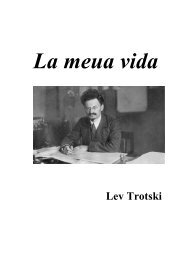A given commodity, e.g., a quarter <strong>of</strong> wheat is exchanged for x blacking, y silk, or z gold, &c. –in short, for other commodities in the most different proportions. Instead <strong>of</strong> one exchange value,the wheat has, therefore, a great many. But since x blacking, y silk, or z gold &c., eachrepresents the exchange value <strong>of</strong> one quarter <strong>of</strong> wheat, x blacking, y silk, z gold, &c., must, asexchange values, be replaceable by each other, or equal to each other. Therefore, first: the validexchange values <strong>of</strong> a given commodity express something equal; secondly, exchange value,generally, is only the mode <strong>of</strong> expression, the phenomenal form, <strong>of</strong> something contained in it,yet distinguishable from it.Let us take two commodities, e.g., corn and iron. The proportions in which they areexchangeable, whatever those proportions may be, can always be represented by an equation inwhich a given quantity <strong>of</strong> corn is equated to some quantity <strong>of</strong> iron: e.g., 1 quarter corn = x cwt.iron. What does this equation tell us? It tells us that in two different things – in 1 quarter <strong>of</strong> cornand x cwt. <strong>of</strong> iron, there exists in equal quantities something common to both. The two thingsmust therefore be equal to a third, which in itself is neither the one nor the other. Each <strong>of</strong> them,so far as it is exchange value, must therefore be reducible to this third.A simple geometrical illustration will make this clear. In order to calculate and compare theareas <strong>of</strong> rectilinear figures, we decompose them into triangles. But the area <strong>of</strong> the triangle itselfis expressed by something totally different from its visible figure, namely, by half the product <strong>of</strong>the base multiplied by the altitude. In the same way the exchange values <strong>of</strong> commodities mustbe capable <strong>of</strong> being expressed in terms <strong>of</strong> something common to them all, <strong>of</strong> which thing theyrepresent a greater or less quantity.This common “something” cannot be either a geometrical, a chemical, or any other naturalproperty <strong>of</strong> commodities. Such properties claim our attention only in so far as they affect theutility <strong>of</strong> those commodities, make them use values. But the exchange <strong>of</strong> commodities isevidently an act characterised by a total abstraction from use value. Then one use value is just asgood as another, provided only it be present in sufficient quantity. Or, as old Barbon says, “onesort <strong>of</strong> wares are as good as another, if the values be equal. There is no difference or distinctionin things <strong>of</strong> equal value ... An hundred pounds’ worth <strong>of</strong> lead or iron, is <strong>of</strong> as great value as onehundred pounds’ worth <strong>of</strong> silver or gold.”As use values, commodities are, above all, <strong>of</strong> different qualities, but as exchange values they aremerely different quantities, and consequently do not contain an atom <strong>of</strong> use value.If then we leave out <strong>of</strong> consideration the use value <strong>of</strong> commodities, they have only one commonproperty left, that <strong>of</strong> being products <strong>of</strong> labour. But even the product <strong>of</strong> labour itself hasundergone a change in our hands. If we make abstraction from its use value, we makeabstraction at the same time from the material elements and shapes that make the product a usevalue; we see in it no longer a table, a house, yarn, or any other useful thing. Its existence as amaterial thing is put out <strong>of</strong> sight. Neither can it any longer be regarded as the product <strong>of</strong> thelabour <strong>of</strong> the joiner, the mason, the spinner, or <strong>of</strong> any other definite kind <strong>of</strong> productive labour.Along with the useful qualities <strong>of</strong> the products themselves, we put out <strong>of</strong> sight both the usefulcharacter <strong>of</strong> the various kinds <strong>of</strong> labour embodied in them, and the concrete forms <strong>of</strong> thatlabour; there is nothing left but what is common to them all; all are reduced to one and the samesort <strong>of</strong> labour, human labour in the abstract.Let us now consider the residue <strong>of</strong> each <strong>of</strong> these products; it consists <strong>of</strong> the same unsubstantialreality in each, a mere congelation <strong>of</strong> homogeneous human labour, <strong>of</strong> labour power expendedwithout regard to the mode <strong>of</strong> its expenditure. All that these things now tell us is, that humanlabour power has been expended in their production, that human labour is embodied in them.When looked at as crystals <strong>of</strong> this social substance, common to them all, they are – Values.We have seen that when commodities are exchanged, their exchange value manifests itself assomething totally independent <strong>of</strong> their use value. But if we abstract from their use value, thereremains their Value as defined above. Therefore, the common substance that manifests itself inthe exchange value <strong>of</strong> commodities, whenever they are exchanged, is their value. The progress<strong>of</strong> our investigation will show that exchange value is the only form in which the value <strong>of</strong>commodities can manifest itself or be expressed. For the present, however, we have to considerthe nature <strong>of</strong> value independently <strong>of</strong> this, its form.
A use value, or useful article, therefore, has value only because human labour in the abstract hasbeen embodied or materialised in it. How, then, is the magnitude <strong>of</strong> this value to be measured?Plainly, by the quantity <strong>of</strong> the value-creating substance, the labour, contained in the article. Thequantity <strong>of</strong> labour, however, is measured by its duration, and labour time in its turn finds itsstandard in weeks, days, and hours.Some people might think that if the value <strong>of</strong> a commodity is determined by the quantity <strong>of</strong>labour spent on it, the more idle and unskilful the labourer, the more valuable would hiscommodity be, because more time would be required in its production. The labour, however,that forms the substance <strong>of</strong> value, is homogeneous human labour, expenditure <strong>of</strong> one uniformlabour power. The total labour power <strong>of</strong> society, which is embodied in the sum total <strong>of</strong> thevalues <strong>of</strong> all commodities produced by that society, counts here as one homogeneous mass <strong>of</strong>human labour power, composed though it be <strong>of</strong> innumerable individual units. Each <strong>of</strong> theseunits is the same as any other, so far as it has the character <strong>of</strong> the average labour power <strong>of</strong>society, and takes effect as such; that is, so far as it requires for producing a commodity, nomore time than is needed on an average, no more than is socially necessary. The labour timesocially necessary is that required to produce an article under the normal conditions <strong>of</strong>production, and with the average degree <strong>of</strong> skill and intensity prevalent at the time. Theintroduction <strong>of</strong> power-looms into England probably reduced by one-half the labour required toweave a given quantity <strong>of</strong> yarn into cloth. The hand-loom weavers, as a matter <strong>of</strong> fact, continuedto require the same time as before; but for all that, the product <strong>of</strong> one hour <strong>of</strong> their labourrepresented after the change only half an hour’s social labour, and consequently fell to one-halfits former value.We see then that that which determines the magnitude <strong>of</strong> the value <strong>of</strong> any article is the amount<strong>of</strong> labour socially necessary, or the labour time socially necessary for its production. Eachindividual commodity, in this connexion, is to be considered as an average sample <strong>of</strong> its class.Commodities, therefore, in which equal quantities <strong>of</strong> labour are embodied, or which can beproduced in the same time, have the same value. The value <strong>of</strong> one commodity is to the value <strong>of</strong>any other, as the labour time necessary for the production <strong>of</strong> the one is to that necessary for theproduction <strong>of</strong> the other. “As values, all commodities are only definite masses <strong>of</strong> congealedlabour time.”The value <strong>of</strong> a commodity would therefore remain constant, if the labour time required for itsproduction also remained constant. But the latter changes with every variation in theproductiveness <strong>of</strong> labour. This productiveness is determined by various circumstances, amongstothers, by the average amount <strong>of</strong> skill <strong>of</strong> the workmen, the state <strong>of</strong> science, and the degree <strong>of</strong> itspractical application, the social organisation <strong>of</strong> production, the extent and capabilities <strong>of</strong> themeans <strong>of</strong> production, and by physical conditions. For example, the same amount <strong>of</strong> labour infavourable seasons is embodied in 8 bushels <strong>of</strong> corn, and in unfavourable, only in four. Thesame labour extracts from rich mines more metal than from poor mines. Diamonds are <strong>of</strong> veryrare occurrence on the earth’s surface, and hence their discovery costs, on an average, a greatdeal <strong>of</strong> labour time. Consequently much labour is represented in a small compass. Jacob doubtswhether gold has ever been paid for at its full value. This applies still more to diamonds.According to Eschwege, the total produce <strong>of</strong> the Brazilian diamond mines for the eighty years,ending in 1823, had not realised the price <strong>of</strong> one-and-a-half years’ average produce <strong>of</strong> the sugarand c<strong>of</strong>fee plantations <strong>of</strong> the same country, although the diamonds cost much more labour, andtherefore represented more value. With richer mines, the same quantity <strong>of</strong> labour would embodyitself in more diamonds, and their value would fall. If we could succeed at a small expenditure<strong>of</strong> labour, in converting carbon into diamonds, their value might fall below that <strong>of</strong> bricks. Ingeneral, the greater the productiveness <strong>of</strong> labour, the less is the labour time required for theproduction <strong>of</strong> an article, the less is the amount <strong>of</strong> labour crystallised in that article, and the lessis its value; and vice versâ, the less the productiveness <strong>of</strong> labour, the greater is the labour timerequired for the production <strong>of</strong> an article, and the greater is its value. The value <strong>of</strong> a commodity,therefore, varies directly as the quantity, and inversely as the productiveness, <strong>of</strong> the labourincorporated in it.A thing can be a use value, without having value. This is the case whenever its utility to man isnot due to labour. Such are air, virgin soil, natural meadows, &c. A thing can be useful, and theproduct <strong>of</strong> human labour, without being a commodity. Whoever directly satisfies his wants with
- Page 4:
égime, which has been through its
- Page 7:
sins of all state forms. That this
- Page 13 and 14:
It has not occurred to any one of t
- Page 15 and 16:
gradually accumulated small capital
- Page 17 and 18:
from this nonsensical ‘prehistory
- Page 19 and 20:
property: the nucleus, the first fo
- Page 21 and 22:
which produces in all nations simul
- Page 23 and 24:
[8. The Inconsistency of the Ideali
- Page 25 and 26:
The ‘essence’ of the fish is it
- Page 27 and 28:
hence of the relationships which ma
- Page 29 and 30:
labour. In the first case, therefor
- Page 31 and 32:
production and commerce soon calls
- Page 33 and 34:
period begins with the Navigation L
- Page 35 and 36:
more advanced countries, still have
- Page 37 and 38:
over against the individuals, so th
- Page 39 and 40:
eality is only a product of the pre
- Page 41 and 42:
never became more than a city; its
- Page 43 and 44:
Only at this stage does self-activi
- Page 45 and 46:
Modern industry has established the
- Page 47 and 48:
these crises, there breaks out an e
- Page 49 and 50:
Further, as we have already seen, e
- Page 51 and 52:
abolish that; the development of in
- Page 53 and 54:
For the rest, nothing is more ridic
- Page 55 and 56:
III. Socialist and Communist Litera
- Page 57 and 58:
conscious of having overcome “Fre
- Page 59 and 60:
The undeveloped state of the class
- Page 61 and 62:
The Paris CommuneAddress to the Int
- Page 63 and 64:
priests were sent back to the reces
- Page 65 and 66: pregnant. In the full consciousness
- Page 67 and 68: subjected Versailles and the rest o
- Page 69 and 70: The Eighteenth Brumaire of Louis Bo
- Page 71 and 72: For the rest, every fair observer,
- Page 73 and 74: that here “bourgeois republic”
- Page 75 and 76: Eternalization of historic relation
- Page 77 and 78: and becomes a direct object and ser
- Page 79 and 80: each supplies the other with its ob
- Page 81 and 82: generally. The question evidently b
- Page 83 and 84: is thus the only reality, the movem
- Page 85 and 86: smudge over all historical differen
- Page 87 and 88: elations. Thus e.g. the relation of
- Page 89 and 90: a rise of wages, because every reac
- Page 91 and 92: equally spent upon all articles of
- Page 93 and 94: Apart from some years of failing ha
- Page 95 and 96: enable a currency to adapt itself t
- Page 97 and 98: Smith and his French predecessors h
- Page 99 and 100: conditions of production, with a gi
- Page 101 and 102: in a commodity constitutes its valu
- Page 103 and 104: y working which the working man wou
- Page 105 and 106: just seen that the surplus value co
- Page 107 and 108: increased value of his labour, like
- Page 109 and 110: altogether, is sure to have his wag
- Page 111 and 112: theory, which consists in putting a
- Page 113 and 114: Preface to A Contribution to the Cr
- Page 115: Capital, Volume I (1867)From the Pr
- Page 119 and 120: imposed necessity, without which th
- Page 121 and 122: embodiments of one identical social
- Page 123 and 124: abstract. The twofold social charac
- Page 125 and 126: ased on the production of commoditi
- Page 127 and 128: Capital Vol. III. Chapter 2. The Ra
- Page 129 and 130: specific relationship to surplus-va



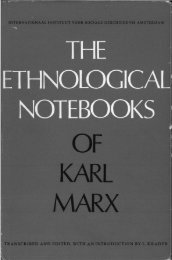

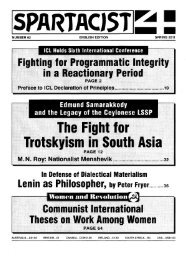

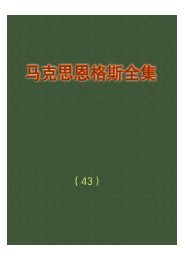
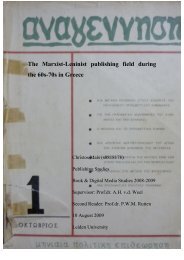
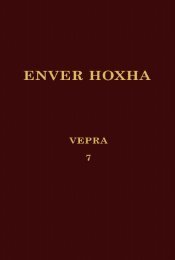
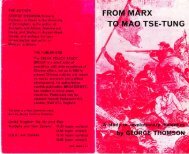

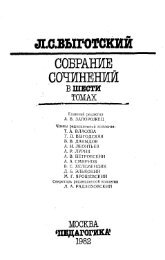
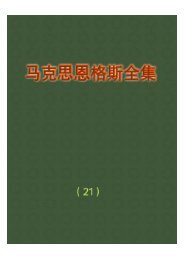
![tyf Enf=O=n]lgg](https://img.yumpu.com/47584932/1/190x245/tyf-enfonlgg.jpg?quality=85)
